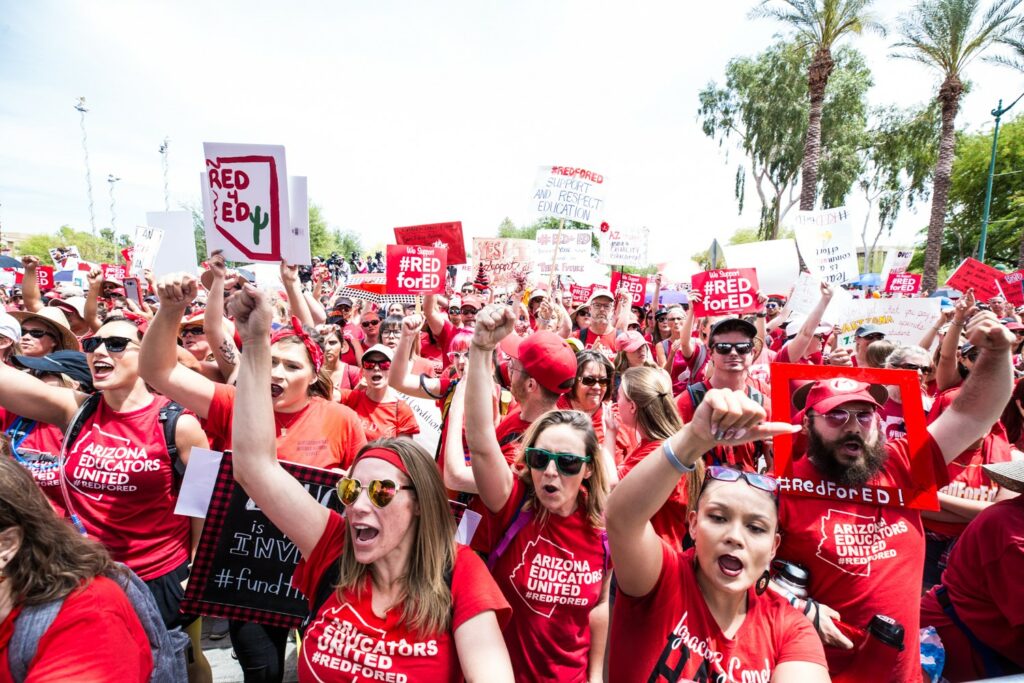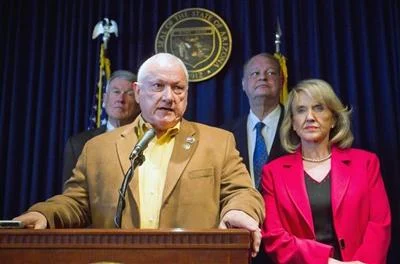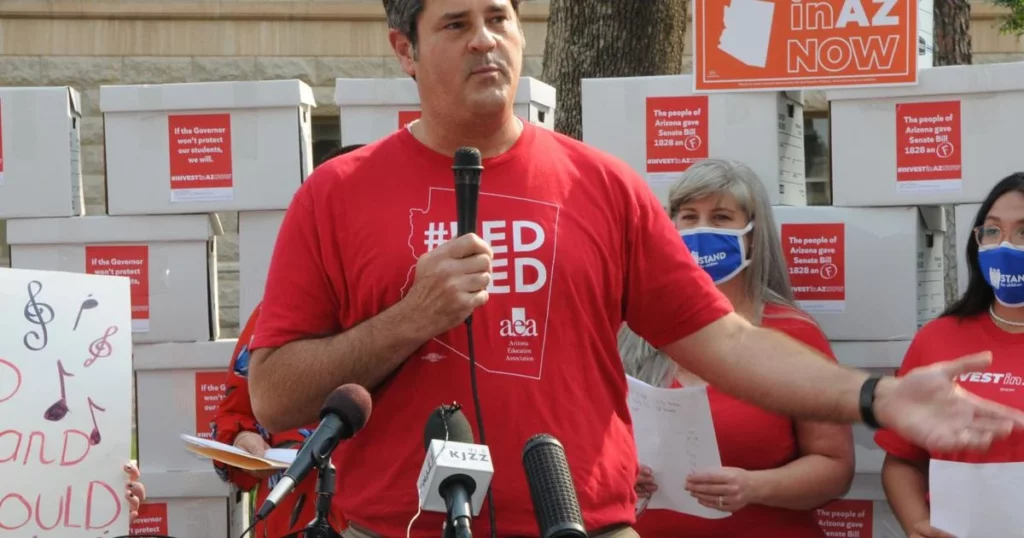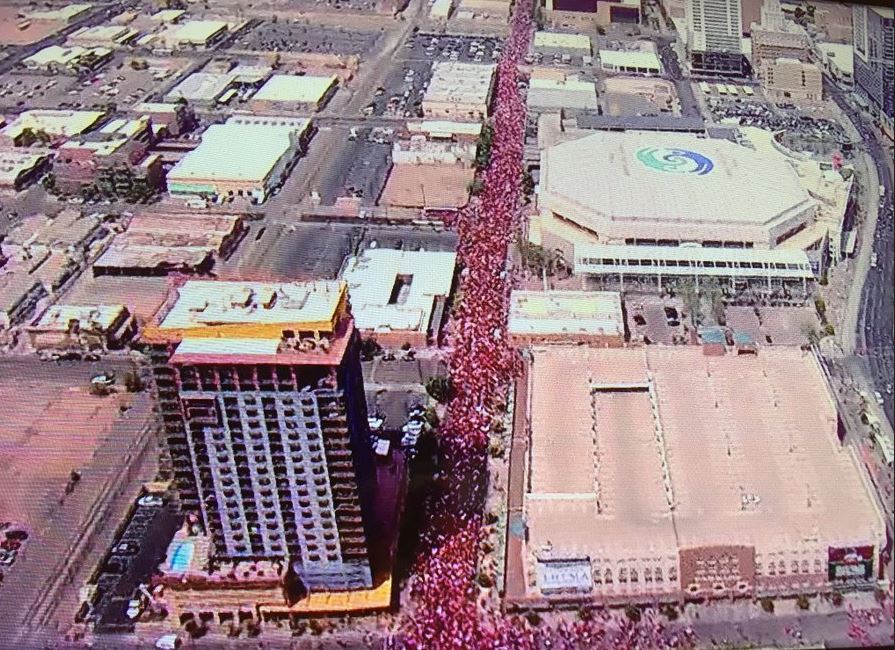
By Maxwell Shevek
In April of 2018 Arizona teachers came together and accomplished something we would have thought impossible just months before. Inspired by teachers across the nation, particularly in West Virginia where the RedForEd movement began that February, 70,000 of us had donned red shirts and walked out of our respective schools across the state to demonstrate at the capitol in downtown Phoenix. It filled us with hope for change. We finally felt empowered to do the job we had been told we signed up for: to serve our communities, to positively impact our students, and to lay the groundwork for a brighter future. At the end of the demonstration, rebuffed by a recalcitrant state government and exhausted by days of demonstrations, marches, and media attention, we turned instead to the political process. Social media posts of “RedForEd” changed to “RememberInNovember.” (Not to be confused with the IWW’s own “In November, We Remember”*) Sadly, four years and two ballot propositions later, we have little to show for our efforts.

A Desperate Need for Education Funding
The problems that led us to walk out on our schools and march were serious. Teachers not only faced low pay, the lowest in the nation by some metrics, but also long hours, inflated class sizes, and dwindling supply budgets for schools and classrooms. Many teachers, already stretching their personal budgets to make ends meet, taking second and third jobs, found themselves using personal money to supply their classrooms. Teacher turnover was also at a high, with many teachers leaving the profession in their first three years and school districts struggling to fill vacancies.
The funding problem had been growing as the Arizona legislature slashed over $2.4 billion from Arizona schools since the recession of 2008-2010. Even though the economy had recovered, they had not replaced those needed funds. The solution to these issues was simple and clear: Arizona needed $2.4 billion more in education funding.
Taking our cue from West Virginia, Arizona teachers began to organize; not from the top down, but from the bottom up. It started with social media groups and quickly grew. Teachers formed a group called Arizona Teachers United (quickly renamed Arizona Educators United – AEU) and began to take action.
We marched outside of radio stations interviewing then governor Doug Ducey; we protested at the capitol where legislators were voting on a bill to expand private school vouchers; West Valley teachers staged a sick out; and teachers at schools across the state, including my own, staged “walk-ins”–which do not disrupt the school day but are a great demonstration of solidarity–wearing red and marching into school together.
These actions culminated in a six-day teacher strike. School districts across the state closed as educators gathered each day at the capitol demanding proper funding, not just for teacher pay, but to improve conditions for students and all school staff.
We met stiff resistance. The governor refused to meet with our representatives; legislators attacked teachers, calling us pawns in a bolshevik conspiracy; and far right media outlet Brietbart ran a hit piece on AEU leader Noah Karvelis.
Still, there was room for optimism. West Virginia Teachers had gotten results: a 5% pay increase for all state employees, not just for educators.
Governor Ducey also seemed to be swaying under the pressure. He put into motion a plan to increase teacher pay; however, crucially he avoided addressing any other demands. The funding for this pay increase would come from cuts elsewhere rather than higher taxes on the wealthy or a true budget increase. Teachers initially rejected this proposal. We saw that real funding increases were needed if we were going to give our students the support they needed. Though this concession from the governor and legislature was miraculous and swift – $200,000,000 (!) in teacher pay raises over the next three years – considering where things stood before the demonstrations began, more was clearly needed.

From Direct Action to Electoral Politics
However, our momentum couldn’t last forever. After six days of demonstrations at the capitol, and under the advice of the Arizona Education Association, the state affiliated of the National Education Association, which had joined to help organize the walk out, we saw no choice but to return to our classrooms.
We told ourselves, however, that the battle was not over. We will “Remember in November”. We will organize politically and, through a ballot initiative, gain the real education funding our schools so desperately needed. The AEA was strongly pushing this alternative as the next step, and the teachers were told to believe that the political process could be even more effective than our demonstrations. Sadly, this would not be the case.
Our first attempt was Prop 207 in 2018, called “Invest in Ed”. The proposition proposed over $600 million in new education funding through tax increases on Arizona’s wealthy. Teachers gathered nearly twice the number of required signatures. I got everyone I knew to sign. This effort was wasted, however, when the Supreme court, packed with Ducey appointments, kicked Prop 207 off the ballot, quibbling over minor language in its summary to petition signers.
Round two came two years later with 2020’s Prop 208. This initiative again aimed at raising education funding through tax increases on those who took home $250,000 or more per year. Though it would make it on the ballot and be passed by Arizona voters, it would be challenged in court in a lawsuit brought by the Goldwater Institute. Big surprise, the initiative was determined to be unconstitutional by the Arizona Supreme Court. Governor Ducey, who again appointed most of the Supreme Court, would call this a win for Arizona taxpayers.

A Job Left Undone
In summary, the message of these events is loud and clear: the walkouts were tough, but they moved the needle, even if only partially. The ballot initiatives did not. Note, too, that the ballot initiatives did not fail due to lack of public support. Prop 207 gained an astonishing number of signatures in 2018 before being struck down by the courts. Meanwhile, a majority of 2020 Arizona voters approved Prop 208. It passed, but the conservative courts still struck it down.
How can we claim to live in a democracy when the system shows such disdain for the will of the people? And how can we trust such a corrupt and insurmountable political process, dedicated to the preservation of monied interests and the status quo, even in the face of dilapidated schools and teacher shortages? How much more could Arizona teachers have gotten if we had continued the walk out instead of “remembering in November”?
Voting will not be enough on its own; mass action is required. Working people must embrace direct action rather than leaving our interests in the hands of a process designed to oppress and exploit us. Labor must organize, demonstrate, march, and strike until our needs are met and our interests become society’s priority rather than protecting the profits of a privileged few.
Teachers organized once; we can do it again. The problems in education are even more severe than they were four years ago. Schools are still underfunded, pay is still too low, and the problem of teaching vacancies is worse than ever. If, like me, you are a teacher in Arizona, first ask yourself, what can we do about this? Then, ask your coworkers to join you.
* The IWW’s “In November, We Remember” refers to Labor’s Martyrs killed in November – the Haymarket martyrs in 1887, Joe Hill in 1915, the Everett Massacre victims of 1916, Wesley Everest in 1919, those killed in the Columbine Massacre of 1927, and many more. November is the month in which we memorialize all of our fallen, past and present, in the struggle for the Emancipation of the Working Class.

redcard.iww.org
